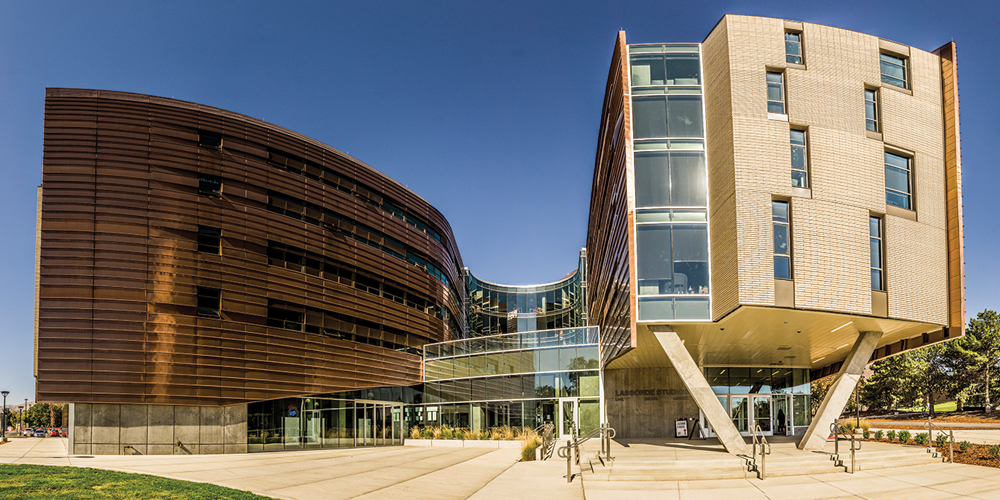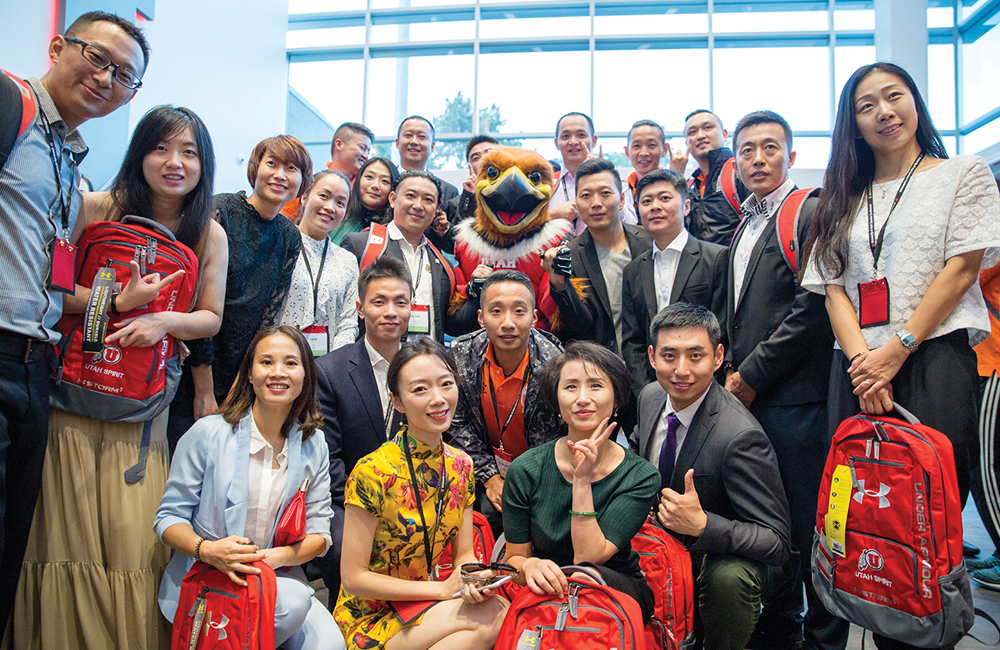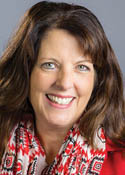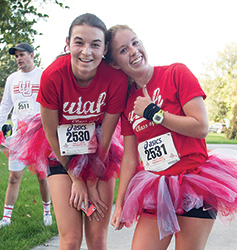Author: Continuum staff
Going Global
Campus Scene
Updates
Discovery
Alum News
Class Notes
One More
Updates
Lassonde Studios Opens Its Doors
After much anticipation and excitement, the new Lassonde Studios opened in August to welcome its first cohort of 400 student residents. The $45 million facility is a place where students from any major or background can live, create new products, and launch companies.
A nationally ranked division of the David Eccles School of Business, the Lassonde Institute announced the building project in April 2014 and broke ground in October of the same year. During construction, Lassonde Studios received worldwide attention, with features in publications such as the New York Times, Fast Company, and Bloomberg.
Lassonde Studios is about 160,000 square feet on five floors. The first floor is a 20,000-square-foot innovation space, workshop, and cafe open to all students on campus. That floor has many spaces and tools, including workbenches, group work areas, 3-D printers, a laser cutter, power tools, and more. The first floor is similar to a student union for those interested in entrepreneurship and innovation. Above are four floors of student housing.
More than 1,300 students applied to live at Lassonde Studios this year. Those selected are often referred to as the “Lassonde 400.” This year’s residents have a variety of academic interests—the most popular include business, engineering, computer science, video games, and film—and they are 37 percent female, 63 percent male. Half are freshmen, and the rest span across every class, including graduate students. “We think we have assembled one of the best groups of entrepreneurs anywhere,” says Troy D’Ambrosio BA’82, executive director of the Lassonde Institute. “We can’t wait to see what the Lassonde 400 accomplishes this year and in the future.”
Lassonde Studios is made possible through the vision and generosity of Pierre Lassonde MBA’73, a world-renowned gold investor, founder of the Franco-Nevada Corporation, and U alumnus who has donated $25 million to support the Lassonde Studios and related programs “We wanted to create a community of entrepreneurs unlike anything anywhere else,” says Lassonde. “The Lassonde Studios will help make this possible by providing all the space and tools students need to do amazing things. The University of Utah is now the place to be for young entrepreneurs.”
Learn more about the Lassonde Studios at lassonde.utah.edu/studios.
Learn more about the Lassonde Institute at lassonde.utah.edu.
The FanUp Pledge
The U invites its loyal sports supporters far and wide to “FanUp” and stake our claim as one of the best fan bases in the nation. Last spring, President David Pershing formed a committee of students, trustees, athletes, fans, alums, and university employees to create a campaign to promote the kind of sportsmanship that reflects the values of the University of Utah. As a result, the university launched the FanUp campaign asking fans everywhere to take the following pledge.
I WILL:
1. Love our Utes and welcome visiting teams and their fans
2. Promote a family-friendly experience
3. Enjoy the game responsibly
4. Cheer loud and be Ute Proud!
The campaign also has designated a text number to report poor fan behavior during a sporting event. Text “FANUP <issue and location>” to 69050.
UMOJI Mania
 Good news for those who are tired of using the high-five emoji as a substitute for Flash-the-U. The U has released an official emoji keyboard called UMOJI —with a “Lite” version for free and a paid version with more choices for $1.99. The icons are available in the App Store and Google Play Store, and can be found by searching “Utah Umoji.”
Good news for those who are tired of using the high-five emoji as a substitute for Flash-the-U. The U has released an official emoji keyboard called UMOJI —with a “Lite” version for free and a paid version with more choices for $1.99. The icons are available in the App Store and Google Play Store, and can be found by searching “Utah Umoji.”
Click here for the UMOJIS page.
Manufacturing a Brighter Future
One of the hot-button issues these days is outsourcing overseas. The big question is how to keep jobs in America. To help convince businesses they can perform better in their own backyard, two U mechanical engineering professors, Bruce Gale PhD’00, and Bart Raeymaekers (pictured L to R), established a center to show local manufacturing companies how they can spur innovation and utilize the latest technology.
The new Manufacturing Extension Partnership (MEP) Center will deliver services for small and medium-sized manufacturing companies by providing expertise in advanced technology, innovation, worker education, operational excellence, and investment strategies. “The goal of the program is to provide these services so businesses can remain competitive against cheap overseas labor and to keep those manufacturing jobs here,” explains Raeymaekers.
In partnership with other entities and organizations throughout the state, the center will help local businesses use data to identify products and growing markets and provide prototyping resources. The MEP Center receives funding from the U.S. commerce department’s National Institute of Standards and Technology and the Utah Governor’s Office of Economic Development. All told, the center will receive $16 million in funding over the next five years.
The center is under the U’s College of Engineering and engages more than a dozen permanent employees, consultants, and industry professionals. Headquartered on campus, it will also have satellite offices in Cache and Utah counties as well as consultants in eastern Utah and Cedar City.
Chinese Coaches Train on Campus
The U has had a few extra coaches hanging around campus this fall—89, to be exact, and all from China. The high school coaches are here as part of the first-ever China coaches training program. For three months, they are training with U Athletics staff to learn coaching techniques for sports including men and women’s basketball, track and field, swimming, and cheerleading.
Part of the Pac-12 Globalization Initiative and funded by the Chinese Scholarship Council, the program specifically focuses on coaching strategy, game preparation, film review, assistant coach development, and practice structure. In addition, the curriculum includes off-the-field items such as sports psychology, strength training, nutrition, public relations, and marketing.
The program is coordinated through the U’s Office for Global Engagement. “A critical part of the U’s mission is to explore and better understand the interconnectivity between people and places around the world, and then apply that learning here at home,” says Michael Hardman BS’71 MEd’73 PhD’75, chief global officer for the U. “This very unique program brings some of China’s best high school coaches to our campus, providing us the opportunity to share our expertise as well as learn from and about Chinese culture.”
Uni Introduces Suicide Prevention App
 Utah children and teens in crisis have a new way to reach out for help. An app developed by the U’s Neuropsychiatric Institute (UNI) aims to reduce the suicide rate among young people in Utah. The SafeUT app is a statewide service funded by the Utah Legislature that provides real-time crisis intervention to youth through texting and a tip program.
Utah children and teens in crisis have a new way to reach out for help. An app developed by the U’s Neuropsychiatric Institute (UNI) aims to reduce the suicide rate among young people in Utah. The SafeUT app is a statewide service funded by the Utah Legislature that provides real-time crisis intervention to youth through texting and a tip program.
Students can use their smartphones to connect directly via chat, text, or a call to licensed clinicians trained in mental health crisis management and suicide prevention. Clinicians are available 24/7 to assist with a wide variety of problems, including emotional crisis, grief, bullying, addiction, abuse, mental health issues, and suicidal behavior.
The SafeUT app is free, anonymous, and confidential. The program has rolled out to more than 160 schools so far and plans to enroll all Utah schools in the program by next summer.
Download the app at the iTunes store, Google Play and elsewhere.
Welcome to the First Cohort of Students from the U’s Asia Campus
In 2014, the University of Utah Asia Campus (UAC) opened its doors in Incheon, South Korea, to students looking for a global and culturally diverse education. This fall, the U welcomed the first group of students from the campus to Salt Lake City to complete their degrees.
Although most undergraduate students will spend three years at the Asia campus before finishing their degrees in Utah, several of these students are on an accelerated path and have already accrued enough credits to enter the U’s main campus as college seniors. The group also includes graduate students in the master of public health program, who are coming to complete the second year of the two-year program.
Fall 2016 enrollment at the UAC has increased to 225 students, and next year, a larger cohort of about 60-70 undergraduate and graduate students are expected to arrive in Salt Lake City. As the UAC increases its degree offerings in the years to come, more than 300 students are anticipated to arrive each year to complete their U degrees.
As one of the founding institutions of Incheon Global Campus, the U currently offers undergraduate degrees in communication, psychology, and social work, and the master of public health. Planning is under way for four new degrees to be offered beginning in spring 2017. Students will soon be able to get an undergraduate degree in film and media arts or urban ecology, a master’s degree in biomedical informatics, or a Global Juris Doctorate.
The global campus also includes Belgium’s Ghent University, George Mason University, and the State University of New York, Stony Brook. All students attending the UAC meet the same admissions and program degree requirements as main campus students, are taught and mentored by qualified U faculty, and receive a University of Utah degree.
The U will accept student applications for the spring semester until Jan. 15, 2017, and admission will be granted on a rolling basis. Main campus students are encouraged to take advantage of a global learning abroad experience at the UAC.
The Asia campus also celebrated the opening of its new building in September. The nine-story, 170,000-square-foot facility is modeled after the iconic J. Willard Marriott Library. The LEED-certified building includes a welcome center, student lounge, 26 lecture halls and classrooms, counseling center, and more than 100 faculty and student support offices.
Utah Entrepreneur Joins Board of Trustees
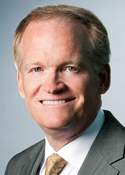 James Lee Sorenson BS’75 has been named a member of the university’s Board of Trustees. A globally prominent entrepreneur, Sorenson has built highly successful enterprises in fields ranging from technology and life sciences to real estate and private equity investment, all of which have added thousands of jobs to Utah’s economy.
James Lee Sorenson BS’75 has been named a member of the university’s Board of Trustees. A globally prominent entrepreneur, Sorenson has built highly successful enterprises in fields ranging from technology and life sciences to real estate and private equity investment, all of which have added thousands of jobs to Utah’s economy.
After launching several successful business ventures while still a U student, Sorenson became a leader in the field of digital video compression and later co-founded Sorenson Capital. In 2013, he provided the U with a $13 million gift to create the James Lee Sorenson Global Impact Investing Center.
“As Utah’s flagship institution of higher learning, this great university has a major impact not only on the city and state I choose to call home, but in the nation and the world,” says Sorenson. “I’m honored to serve on the Board of Trustees for my alma mater.”
Pharmacy College Appoints New Dean
 Randall Peterson, a prominent Harvard chemical biologist who pioneered the use of zebrafish to discover new precision drug therapies for cardiovascular and nervous system disorders, has been tapped to serve as dean of the College of Pharmacy. He assumes his role as dean and L.S. Skaggs Presidential Endowed Chair for Pharmacy effective Jan. 1, 2017.
Randall Peterson, a prominent Harvard chemical biologist who pioneered the use of zebrafish to discover new precision drug therapies for cardiovascular and nervous system disorders, has been tapped to serve as dean of the College of Pharmacy. He assumes his role as dean and L.S. Skaggs Presidential Endowed Chair for Pharmacy effective Jan. 1, 2017.
A Salt Lake City native, Peterson holds an undergraduate degree in molecular biology from Brigham Young University and a doctorate in biochemistry from Harvard University. Until Jan. 1, he is associate professor of medicine at Harvard Medical School, Charles and Ann Sanders Research Scholar at Massachusetts General Hospital, and senior associate member of the Broad Institute.
New Refugee Services Center Launches
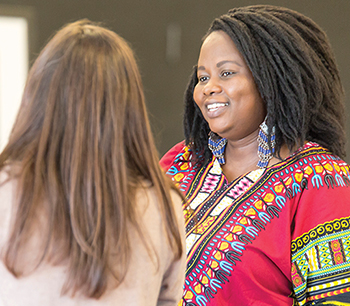 Utah has a population of around 65,000 refugees, according to Department of Workforce Services data, and that number grows by nearly 1,000 each year without accounting for other immigrants. Recognizing the challenges these new Americans face assimilating to their new environment, the U’s College of Social Work recently launched the Center for Research on Migration & Refugee Integration.
Utah has a population of around 65,000 refugees, according to Department of Workforce Services data, and that number grows by nearly 1,000 each year without accounting for other immigrants. Recognizing the challenges these new Americans face assimilating to their new environment, the U’s College of Social Work recently launched the Center for Research on Migration & Refugee Integration.
The center focuses on welcoming and integrating immigrants and refugees into mainstream communities and also serves as a hub for research. It is the first academic center of its kind west of the Mississippi River and is the result of a year-long discussion between the college, university faculty, and community partners including the Office of Refugee Services, International Rescue Committee, and Utah Department of Workforce Services.
Both university and community researchers will network through the center to explore issues related to immigration and refugee integration. Areas of immediate research focus include youth and parenting challenges; development of a certification process for accepting academic and professional degrees granted in other countries; and an assessment of currently available services and research on refugee and immigrant issues.
Iconic Wall Mansion to Serve as Off-Campus Embassy
The historic Wall Mansion in the heart of Salt Lake City has a new name and purpose. The recently refurbished building opened in August and has been renamed the Thomas S. Monson Center after the current president of The Church of Jesus Christ of Latter-day Saints. Monson BS’48 is a distinguished alumnus of the U’s David Eccles School of Business, a past faculty member, and an honorary doctorate recipient.
The mansion is now home to the Kem C. Gardner Policy Institute, which develops and shares economic, demographic, and public policy data to help business and community leaders make more informed decisions. The new center will play a pivotal role in bringing economists, business leaders, and civic authorities together to examine issues pertinent to the state of Utah, and advance policies that will stimulate its growth and development. The mansion also provides a space for community gatherings and private events, encouraging further interaction between the U and the community it serves.
The historic 50,000-square-foot mansion has been restored to its original elegance and function, including restoring the original east entrance to its former state. The mansion was designed by renowned architect Richard K. A. Kletting, who also designed the Utah State Capitol. Enos A. Wall, who remodeled and enlarged the home into a Renaissance villa, purchased the property in 1904 and lived in it until 1920. After serving as the Jewish Community Center and then LDS Business College, the mansion was donated to the U by the LDS church in 2014.
Learn more about Kem Gardner here.
Happy Birthday, Swoop!
 The U’s beloved mascot, a red-tailed hawk named Swoop, turned 20 in 2016. Festivities ensued, including a party at the Campus Store and a halftime celebration during the first home football game. Instead of gifts, Swoop requested donations of school supplies for local children. Lowell Bennion Community Service volunteers responded by helping stuff 400 bags with school necessities that Swoop helped distribute to Lincoln Elementary School students in Salt Lake City.
The U’s beloved mascot, a red-tailed hawk named Swoop, turned 20 in 2016. Festivities ensued, including a party at the Campus Store and a halftime celebration during the first home football game. Instead of gifts, Swoop requested donations of school supplies for local children. Lowell Bennion Community Service volunteers responded by helping stuff 400 bags with school necessities that Swoop helped distribute to Lincoln Elementary School students in Salt Lake City.
After having gone many years without an official mascot, the U introduced the indigenous bird as the new symbol of school spirit in 1996. Since then Swoop has been busy bolstering Ute pride, whether he’s energizing crowds, high-fiving kids, or helping at charity events. Cheers to you, Swoop!
Find out more about the student who named Swoop 20 years ago here.
Web Exclusive Video
Check out a video tribute to Swoop made by U student filmmakers:
Campus Scene: Farewell to OSH
Farewell to OSH
Orson Spencer Hall, affectionately known by nearly everyone throughout its 60-plus years on campus as “OSH,” is no more. The two-story, mid-century modern building was razed in late October. Named for the first chancellor of the university, OSH was one of the first post-WWII structures on campus designed exclusively for classrooms. Nearly every U student since then has had a class in OSH and can probably still remember the sound of the bell signaling five-minute class breaks and the ensuing swarms of students navigating the crowded halls. Those times will be missed. OSH will be replaced by the new Carolyn and Kem Gardner Building.
Web Exclusive Photo Gallery
[nggallery id=134]
Discovery
Super Sleepers or Dangerously Drowsy?
 Most people could benefit from a few extra hours of sleep every night. But some people habitually sleep much less than the recommended amount, yet report feeling no ill effects. A new University of Utah study finds that patterns of neural connections in the brains of so-called “habitual short sleepers” suggest that some of these people may indeed be efficient sleepers, but they may also be more tired than they realize, leading to potential safety issues, such as during routine night driving.
Most people could benefit from a few extra hours of sleep every night. But some people habitually sleep much less than the recommended amount, yet report feeling no ill effects. A new University of Utah study finds that patterns of neural connections in the brains of so-called “habitual short sleepers” suggest that some of these people may indeed be efficient sleepers, but they may also be more tired than they realize, leading to potential safety issues, such as during routine night driving.
“Most people feel terrible when they get less than six hours of sleep,” says psychology associate professor Paula Williams. “What’s different about these short sleepers who feel fine? Is there something different going on in terms of brain function? Although they report no daytime dysfunction from short sleep, what if their perceptions are inaccurate?”
To begin answering those questions, study co-authors Williams, neurologist Christopher Jones, associate professor and radiologist Jeff Anderson, and psychology graduate student Brian Curtis BS’08 MS’15 (first author on the new study, published in Brain and Behavior) looked into how people’s brains are wired. The team compared data from people who reported a normal amount of sleep in the past month with those who reported sleeping six hours or less a night. They further divided the short sleepers into two groups: Those who reported daytime dysfunction, such as feeling too drowsy to perform common tasks or keep up enthusiasm, and those who reported feeling fine.
Both groups of short sleepers exhibited connectivity patterns more typical of sleep than wakefulness while in an MRI scanner. Anderson says that although people are instructed to stay awake while in the scanner, some short sleepers may have briefly drifted off, even those who denied dysfunction. “People are notoriously poor at knowing whether they’ve fallen asleep for a minute or two,” he says. For the short sleepers who deny dysfunction, one hypothesis is that their wake-up brain systems are typically in overdrive. “This leaves open the possibility that in a boring MRI scanner they have nothing to do to keep them awake and thus fall asleep,” says Jones.
This hypothesis has public safety implications, according to Curtis. “Other boring situations, like driving an automobile at night without adequate visual or auditory stimulation, may also put short sleepers at risk of drowsiness or even falling asleep behind the wheel,” he says. The next phase of the team’s research will directly test whether short sleepers who deny dysfunction are actually doing fine. In addition to brain imaging, researchers will examine cognitive performance, including during driving simulator testing.
The full study can be found here.
Hippo Teeth Reveal Risks to African Grasslands
Grasslands are an important ecosystem in Africa, hosting many animals and serving as corridors for wildlife movement. A new U study published in Scientific Reports finds that loss of megaherbivores such as elephants and hippos can lead to rapid environmental and ecological change in grasslands, endangering the overall ecosystem.
Trees and non-grassy plants compete with grasses, but grazing by the large herbivores keeps the woody plants in check. Study first author and U postdoctoral scholar Kendra Chritz studied hippopotamus teeth to find a shift in the diet of hippos over the course of a decade in Uganda’s Queen Elizabeth National Park following widespread elephant poaching in the 1970s. “Within 10 years, we see a big change in what’s happening in this once diverse grassy area of the park,” says Chritz. “This is a window into the future of what could happen in East African savannas as elephants continue to be poached at the currently unprecedented rate.”
People can combat poaching by reducing the demand and financial incentive for harvesting the elephants’ tusks, Chritz says. “Not purchasing ivory and knowing which products you might use that are made from ivory is the best thing you can do to protect elephants.”
The full study can be found here.
Related update: A U study published in November 2016 found that more than 90 percent of ivory in large seized shipments came from elephants that died less than three years prior. Read the news release here.
New Agent From Blood Could Fight Harmful Inflammation
A factor found in umbilical cord blood could become the basis for developing a new therapy to fight harmful inflammation, U School of Medicine researchers report. When given to mice, the newly discovered factor countered signs of inflammation and sepsis, such as fever, fluctuations in respiratory rate, and even death. The factor circulates in the blood of newborns for about two weeks after birth and is not found in older babies or adults, according to the study published in The Journal of Clinical Investigation.
“We found something we weren’t expecting, and it has taken us to new strategies for therapy that didn’t exist before,” says Guy Zimmerman, professor of internal medicine and senior author who carried out the investigation in collaboration with lead author and associate professor of pediatrics Christian Con Yost BS’93 MD’97, along with colleagues at the U School of Medicine.
Anyone who has twisted an ankle or been stung by a bee is familiar with inflammation and its telltale redness, pain, and swelling, all positive signs that the body is mounting defenses against the insult. But under certain circumstances, inflammation can turn against us, causing damage to healthy tissue. An out-of-control inflammatory response is thought to be behind a diverse spectrum of conditions from rheumatoid arthritis to sepsis, an overreaction to infection and common cause of in-hospital deaths.
In the scientists’ blood factor study, only 20 percent of mice with sepsis survived longer than two to four days without treatment. Mice treated with the cord blood factor had triple the chance for survival, with 60 percent remaining after the same amount of time. The researchers will carry out additional studies to test the therapeutic properties of the blood factor.
The full study can be found here.
Slow Sea Snails May Lead to Speedy Insulin
Researchers at the U have found that the structure of an insulin molecule produced by predatory cone snails may be an improvement over the fast-acting therapeutic insulin currently used for diabetes. The finding suggests that the insulin produced by cone snails to stun their prey could begin working in as few as five minutes, compared with 15 minutes for the fastest-acting insulin currently available for human use.
The Conus geographus predatory cone snail and its relatives have developed complex brews of venoms to rapidly paralyze prey fish before they can swim away. The snails secrete insulin and other compounds into water near fish, causing their blood sugar to plummet, which sedates them for the snails to then easily consume.
Studying the structure of the cone snail insulin could help researchers modify human insulin to lose an inhibiting action called self-aggregation (sticking together and slowing down action), says biologist Helena Safavi, co-author on a paper describing the cone snail insulin published in Nature Structural & Molecular Biology. Safavi says that studying complex venom cocktails can open doors to new drug discoveries. “You can get new ideas from venoms. To have something that has already been evolved—that’s a huge advantage.”
Along with colleagues from Australia, U biochemists Danny Chou and Maria Disotuar as well as biologists Joanna Gajewiak and Baldomero Olivera contributed to the study. A Distinguished Professor, Olivera has long been a leader in researching cone snail toxins for neuroscience.
The full study can be found here.
Alum News
Alumni Association Scholarships
Each spring, the University of Utah Alumni Association is honored to award more than half a million dollars of scholarship money to students, ranging from incoming freshmen to graduate students. That amount usually surprises people, and we are often asked where the money comes from. The simple response is: From you, our alumni and friends.
Whether you’re driving with a U license plate or running in our annual Homecoming 5K race, you’re a contributor. Above, we break down the numbers, including the source of funds as well as scholarship recipient and eligibility information.
Class Notes
1970s

 Randy Dryer BS’73 JD’76 (L) and Kimball Parker BA’09 (R) have each been recognized with a Fastcase 50 Award, which honors those who have charted a new course for the delivery of legal services. Dryer is a Presidential Honors Professor at the U and a professor in the U’s S.J. Quinney College of Law. Parker is a former lawyer with Quinn Emanuel, one of the country’s top law firms. Dryer and Parker were honored for the work they did in creating a project where students “mapped” the law on a website created by Parker called CO/COUNSEL. Parker’s crowdsourcing platform utilizes topic maps (diagrammed by law students) that are then made public and are open to community editing. The combination of the wisdom of experts and the wisdom of crowds creates new avenues for exploring and understanding the law.
Randy Dryer BS’73 JD’76 (L) and Kimball Parker BA’09 (R) have each been recognized with a Fastcase 50 Award, which honors those who have charted a new course for the delivery of legal services. Dryer is a Presidential Honors Professor at the U and a professor in the U’s S.J. Quinney College of Law. Parker is a former lawyer with Quinn Emanuel, one of the country’s top law firms. Dryer and Parker were honored for the work they did in creating a project where students “mapped” the law on a website created by Parker called CO/COUNSEL. Parker’s crowdsourcing platform utilizes topic maps (diagrammed by law students) that are then made public and are open to community editing. The combination of the wisdom of experts and the wisdom of crowds creates new avenues for exploring and understanding the law.
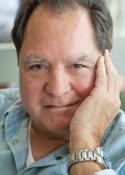 D. Michael Quinn MA’73 won the 2016 Leonard J. Arrington Award, presented annually by the Mormon History Association to a scholar for distinguished and outstanding service to Mormon history. Quinn’s 1987 book Early Mormonism and the Magic World View was described by the selection committee chair as “a prize-winning, imaginative, and pathbreaking study of the relationship between traditional folk magic and early Mormonism.” Quinn’s two biographies of LDS Church President J. Reuben Clark were also praised, and three of his books on the Mormon hierarchy were noted. And although a controversy surrounded his Same Sex Dynamics among 19th Century Americans: A Mormon Example, the book was cited for breaking new ground in Mormon studies.
D. Michael Quinn MA’73 won the 2016 Leonard J. Arrington Award, presented annually by the Mormon History Association to a scholar for distinguished and outstanding service to Mormon history. Quinn’s 1987 book Early Mormonism and the Magic World View was described by the selection committee chair as “a prize-winning, imaginative, and pathbreaking study of the relationship between traditional folk magic and early Mormonism.” Quinn’s two biographies of LDS Church President J. Reuben Clark were also praised, and three of his books on the Mormon hierarchy were noted. And although a controversy surrounded his Same Sex Dynamics among 19th Century Americans: A Mormon Example, the book was cited for breaking new ground in Mormon studies.
1980s
 Akhlesh Lakhtakia MS’81 PhD’83, Charles Godfrey Binder Professor in Engineering Science and Mechanics at the Pennsylvania State University, has been admitted as a Fellow of the Royal Society of Chemistry, a professional society based in the United Kingdom with more than 50,000 members worldwide. Lakhtakia’s admittance was based on his extensive and fundamental contributions to the optical response characteristics of isotropic chiral materials and to homogenization formalisms for composite materials and metamaterials. His research focuses on electromagnetic fields in complex materials, such as sculptured thin films, chiral materials, and bianisotropy. Since joining Penn State in 1983, Lakhtakia has been honored with numerous awards for his teaching and research.
Akhlesh Lakhtakia MS’81 PhD’83, Charles Godfrey Binder Professor in Engineering Science and Mechanics at the Pennsylvania State University, has been admitted as a Fellow of the Royal Society of Chemistry, a professional society based in the United Kingdom with more than 50,000 members worldwide. Lakhtakia’s admittance was based on his extensive and fundamental contributions to the optical response characteristics of isotropic chiral materials and to homogenization formalisms for composite materials and metamaterials. His research focuses on electromagnetic fields in complex materials, such as sculptured thin films, chiral materials, and bianisotropy. Since joining Penn State in 1983, Lakhtakia has been honored with numerous awards for his teaching and research.
 C. Dane Nolan JD’86 was named 2016 Judge of the Year by the Utah State Bar. Appointed to the Third District Juvenile Court in May 2003 by Gov. Michael O. Leavitt, Nolan serves in Salt Lake, Summit, and Tooele counties. Before his appointment, he spent 12 years with the Salt Lake County District Attorney’s Office, where he handled child sexual and physical abuse cases and adult sexual assault prosecutions. He was a founding member of the Utah Minority Bar Association and served as chair of the Judicial Conduct Commission. His service has also included five years with the Juvenile Court Board of Judges, with one term as chair. In 2015, he was recognized as the Utah Board of Juvenile Justice Youth Advocate of the Year. Nolan has presided over Utah’s first Juvenile Mental Health Court since 2006.
C. Dane Nolan JD’86 was named 2016 Judge of the Year by the Utah State Bar. Appointed to the Third District Juvenile Court in May 2003 by Gov. Michael O. Leavitt, Nolan serves in Salt Lake, Summit, and Tooele counties. Before his appointment, he spent 12 years with the Salt Lake County District Attorney’s Office, where he handled child sexual and physical abuse cases and adult sexual assault prosecutions. He was a founding member of the Utah Minority Bar Association and served as chair of the Judicial Conduct Commission. His service has also included five years with the Juvenile Court Board of Judges, with one term as chair. In 2015, he was recognized as the Utah Board of Juvenile Justice Youth Advocate of the Year. Nolan has presided over Utah’s first Juvenile Mental Health Court since 2006.
1990s
 Jill M. Pohlman BS’93 JD’96 was appointed to the Utah Court of Appeals by Gov. Gary Herbert, and her appointment was confirmed by the Utah State Senate. While attending law school at the U, Pohlman served on the Utah Law Review before graduating Order of the Coif. After law school, she clerked for the Honorable David K. Winder of the United States District Court for the District of Utah. Prior to her current appointment, Pohlman was a partner at the law firm of Stoel Rives LLP in Salt Lake City. She practiced there for 19 years, during which time she maintained a complex civil litigation practice. She was a member of the Utah Supreme Court’s Ethics and Discipline Committee, including serving as panel chair. She also served on the Utah Supreme Court’s Diversion Committee. She currently sits on the Utah Courts Committee on Judicial Outreach.
Jill M. Pohlman BS’93 JD’96 was appointed to the Utah Court of Appeals by Gov. Gary Herbert, and her appointment was confirmed by the Utah State Senate. While attending law school at the U, Pohlman served on the Utah Law Review before graduating Order of the Coif. After law school, she clerked for the Honorable David K. Winder of the United States District Court for the District of Utah. Prior to her current appointment, Pohlman was a partner at the law firm of Stoel Rives LLP in Salt Lake City. She practiced there for 19 years, during which time she maintained a complex civil litigation practice. She was a member of the Utah Supreme Court’s Ethics and Discipline Committee, including serving as panel chair. She also served on the Utah Supreme Court’s Diversion Committee. She currently sits on the Utah Courts Committee on Judicial Outreach.
2000s
 Kate Conyers BA’03 JD’08 MPA’08 has received the distinguished American Inns of Court Sandra Day O’Connor Award for Professional Service. The award recognizes excellence in public interest or pro bono activities. Conyers is a felony attorney with the Salt Lake Legal Defender Association, where she has represented hundreds of indigent defendants in all aspects of their criminal cases. She also worked there as a clerk before two stints in private practice, at Snell & Wilmer, LLP, and Lokken and Associates. She has served on the executive committee of Emerging Legal Leaders for the “And Justice for All” program, providing resources to Utah’s nonprofit civil legal aid agencies. She has also volunteered in bar-related programs including Wills for Heroes and Serving Our Seniors.
Kate Conyers BA’03 JD’08 MPA’08 has received the distinguished American Inns of Court Sandra Day O’Connor Award for Professional Service. The award recognizes excellence in public interest or pro bono activities. Conyers is a felony attorney with the Salt Lake Legal Defender Association, where she has represented hundreds of indigent defendants in all aspects of their criminal cases. She also worked there as a clerk before two stints in private practice, at Snell & Wilmer, LLP, and Lokken and Associates. She has served on the executive committee of Emerging Legal Leaders for the “And Justice for All” program, providing resources to Utah’s nonprofit civil legal aid agencies. She has also volunteered in bar-related programs including Wills for Heroes and Serving Our Seniors.
To submit alumni news for consideration, email ann.floor@utah.edu.




 Campus Bids Farewell to Milton Bennion Hall
Campus Bids Farewell to Milton Bennion Hall The U is embarking on an initiative to become the nation’s leader in Pacific Islander studies. As part of the initiative, the university is hiring two new full-time faculty in Pacific Islander studies and recently created a new scholarship aimed at recruiting and retaining talented students of Pacific Island heritage.
The U is embarking on an initiative to become the nation’s leader in Pacific Islander studies. As part of the initiative, the university is hiring two new full-time faculty in Pacific Islander studies and recently created a new scholarship aimed at recruiting and retaining talented students of Pacific Island heritage.
 Student Crowned Ms. Wheelchair America 2017
Student Crowned Ms. Wheelchair America 2017 Pakistani Youth Leaders Here on Exchange
Pakistani Youth Leaders Here on Exchange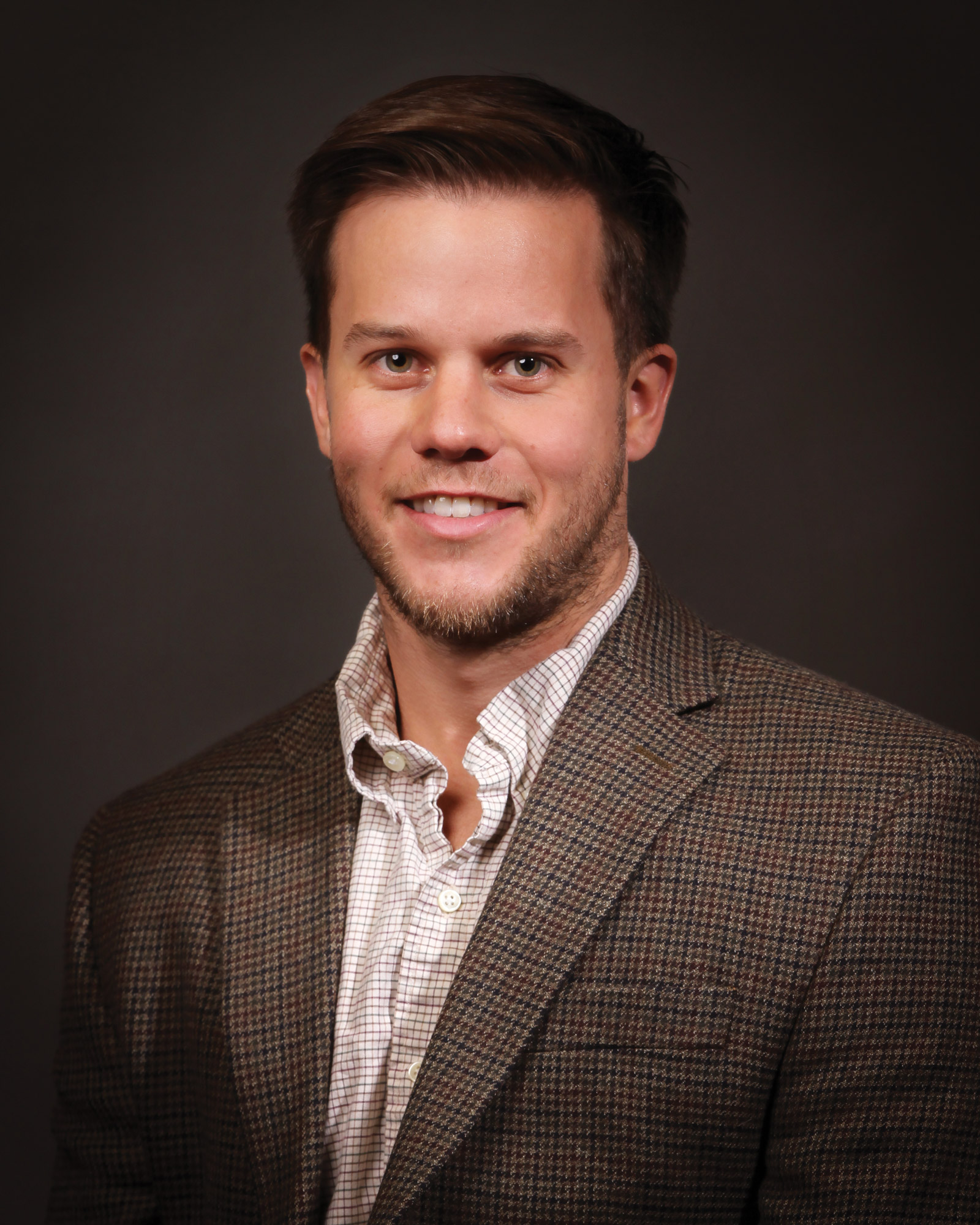 Luther McDonald, a 28-year-old civil and environmental engineering assistant professor, as well as a faculty member in the U’s nuclear engineering program, was just named one of Forbes’ “
Luther McDonald, a 28-year-old civil and environmental engineering assistant professor, as well as a faculty member in the U’s nuclear engineering program, was just named one of Forbes’ “
 “Coffee” was the most tweeted food in the continental U.S. from mid-2014 to mid-2015, followed by “beer” then “pizza.” Besides hinting at which foods are popular, tweets may reveal something about our health. Communities that expressed positive sentiments about healthy foods were more likely to be healthier overall.
“Coffee” was the most tweeted food in the continental U.S. from mid-2014 to mid-2015, followed by “beer” then “pizza.” Besides hinting at which foods are popular, tweets may reveal something about our health. Communities that expressed positive sentiments about healthy foods were more likely to be healthier overall.

 According to the National Resources Defense Council, Americans waste up to $19 billion annually in electricity costs due to “vampire appliances,” always-on digital devices in the home that suck power even when they are turned off.
According to the National Resources Defense Council, Americans waste up to $19 billion annually in electricity costs due to “vampire appliances,” always-on digital devices in the home that suck power even when they are turned off.
 For Sydney Chan, our 2017 Founders Day Scholar, cultural identity has made her who she is—a successful second-year nursing student, an active volunteer with several groups supporting the underrepresented, and an outstanding service leader with the U’s Bennion Center.
For Sydney Chan, our 2017 Founders Day Scholar, cultural identity has made her who she is—a successful second-year nursing student, an active volunteer with several groups supporting the underrepresented, and an outstanding service leader with the U’s Bennion Center. The Alumni Association welcomes a new director of marketing, Andy Cier, an award-winning marketing and communications executive with extensive strategic marketing experience in education, tourism, health care, and government. The University of Utah is lucky to have his expertise.
The Alumni Association welcomes a new director of marketing, Andy Cier, an award-winning marketing and communications executive with extensive strategic marketing experience in education, tourism, health care, and government. The University of Utah is lucky to have his expertise. Your Legacy Can Live On at the Alumni House
Your Legacy Can Live On at the Alumni House





